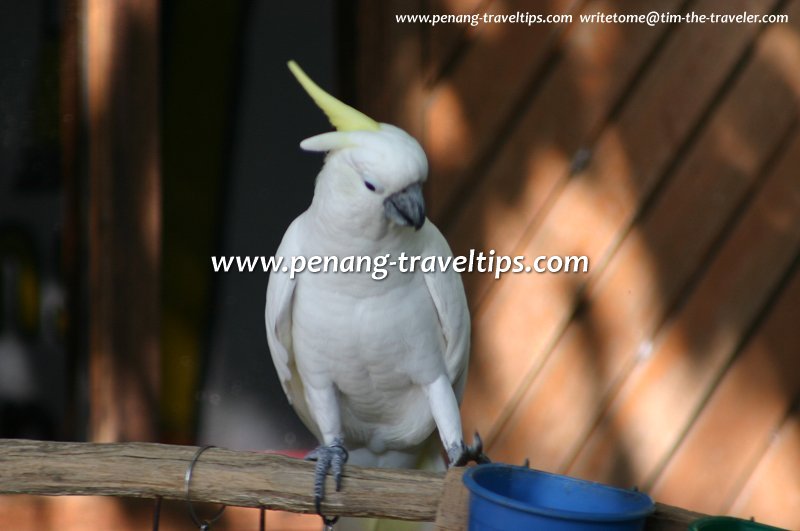 Cockatoo parrot, Penang Bird Park (12 March 2005)
Cockatoo parrot, Penang Bird Park (12 March 2005)
The Penang Bird Park (GPS: 5.3939, 100.39464) in Seberang Jaya has one of the best collections of birds indigenous to Malaysia, including the only full collection of Malaysian hornbills. It was opened on August 8, 1988, and officiated by Dr. Mahathir on November 26 of the same year. Presently it holds about 300 species of birds numbering around 2500 birds.
Contact
Penang Bird Park45, Lintang Kurau 7,
Chai Leng Park,
13700 Perai, Penang.
Phone: 04 399 1899
Hours: 9am-7pm daily
Visiting the Penang Bird Park
I paid a visit to the Penang Bird Park on Saturday, September 18, and met up with Dr Gino Ooi, the park director, to seek his side of the story.Me: Why are the birds on the front porch chained?
Dr Ooi: It's really to protect humans from the birds. Let me explain.
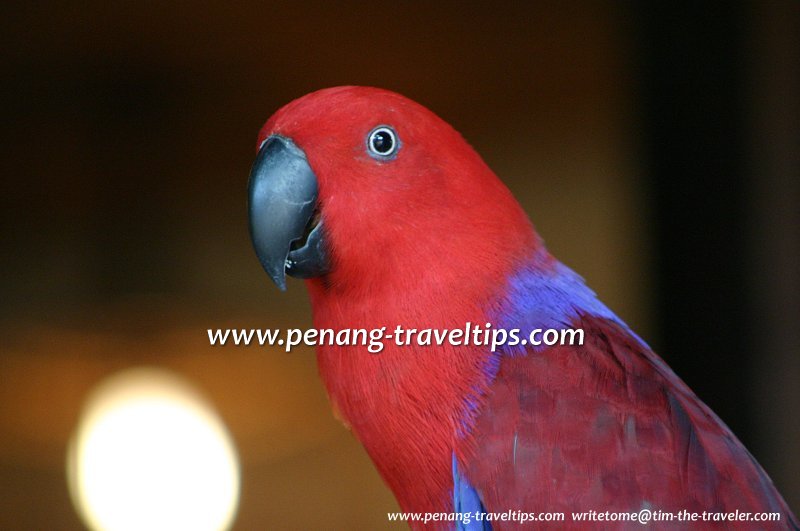 Parrot, Penang Bird Park (12 March 2005)
Parrot, Penang Bird Park (12 March 2005)
The birds on the front porch are very tame. They are bred from chicks in captivity, and have always been familiar with humans. As such, they have no fear of people. Previously, I also have a White-bellied Sea-eagle on the front porch, but no longer place one there anymore, due to a few reasons.
The eagle is very tame and would often fly around if not chained, but will not leave the compound. As it is familiar with humans, it may land on the body of the visitors - and with its claws, can deliver a nasty scratch, especially to young children with delicate skin. Thus keeping the birds chained is to protect the public from the birds.
However, the birds on the porch are released to large enclosure in the evening, and are switched with other birds on a regular basis. In this way, they are not left chained to the front porch all the time.
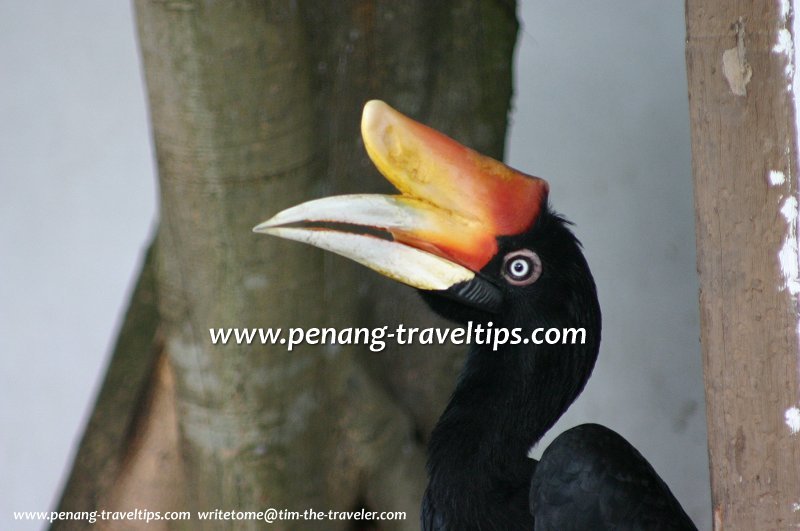 Hornbill, Penang Bird Park (12 March 2005)
Hornbill, Penang Bird Park (12 March 2005)
Another reason why I no longer place a Sea-eagle on the front porch is due to the lack of civility and education among the public. To them, an eagle represents a menace, a predator. On seeing an eagle, the public often want to harm it. Children will throw stones, splash water and other objects at it, and often through the coercion of their parents. This is partly due to upbringing.
When I myself was very young, if I saw an exotic bird, my first reaction was to hit it with a lastic (catapult). Why would I do that? Think about this: if I were to go to my friends and claim that I have seen such-and-such bird, would they believe me? But if I could hit the bird and kill it, then I would secure the evidence in my hands, and share the experience of seeing such a beautiful bird with my friends.
In a way, this is an attitude, still rampant today and that's a pity. This would not be so in the West. Over there, if a child sees an exotic bird, he would go to the library and read all about it, and be delighted to have seen the bird, and see it again at close proximity at their local bird parks. But it is not something that a child in this region could easily do: most children in the rural areas in this country do not have access to libraries, and even when they do, the libraries do not hold books that will provide them the answers. Such children grow up to be adults without the inquisitiveness to learn, but still very curious.
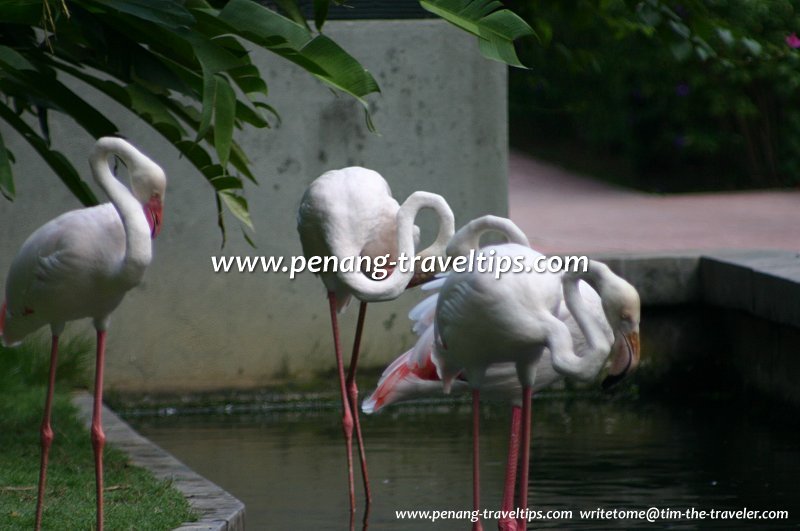 Flamingos, Penang Bird Park (12 March 2005)
Flamingos, Penang Bird Park (12 March 2005)
Me: Why don't you put up a sign warning the public from harming the birds?
Dr Ooi: I find this to be counter productive. The sign only provide a suggestion to the irresponsible ones to harm the birds in secret.
Me: I can't even find the Penang Bird Park. There are no signboards pointing to it.
Dr Ooi: I am aware of that, but there's not much I can do. I have informed the relevant authorities to put up signboards; they have promised to do so, but no action has been taken on this.
Me: What is the public's perception of bird life?
Dr Ooi: On the whole, the general public is still gravely lacking in terms of environmental consciousness. My pelicans, for example, were allowed to fly freely. They may fly within the vicinity and return to the compound of the bird park. Of course, there are times when they fly out of the park, and that's when problem arise.
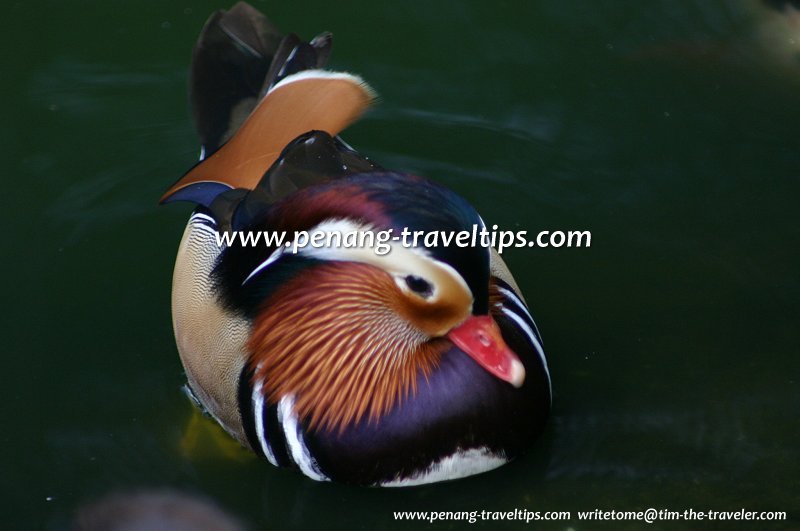 Mandarin Duck, Penang Bird Park (12 March 2005)
Mandarin Duck, Penang Bird Park (12 March 2005)
Once someone caught one of my pelicans, and brought it back to me. I had to buy my own pelican from him! Another time, I managed to track down someone who had caught my pelican - it's not difficult as pelicans are not indigenous to this country. When I asked about the bird, the person told me that the bird was not tasty at all.
Me: Do you trade in birds?
Dr Ooi: I do not trade in any endangered local species, as this is against the law. When I first started in this business, I trapped the birds myself, together with an appointed trapper, licensed by the Department of Wildlife and National Park (Jabatan Perhilitan) Now, due to lack of time, I allowed this licensed trapper to obtained the required birds by himself.
A trained and experienced licensed trapper will have the necessary knowledge of a bird's habitat and well being, and will be able to capture the bird without causing harm to it, or depleting it from the wild. As he is licensed by the Jabatan Perhilitan, he is constantly under the watchful eyes of the Rangers. His house is also regularly inspected by the Rangers to make sure that he is not trapping any other birds required by Penang Bird Park. Take for example the hornbill. If my trapper comes to me with a male hornbill, I will not pay for it, even for 1 sen. Why? If you understand hornbills, you would know better than to catch adult male hornbills.
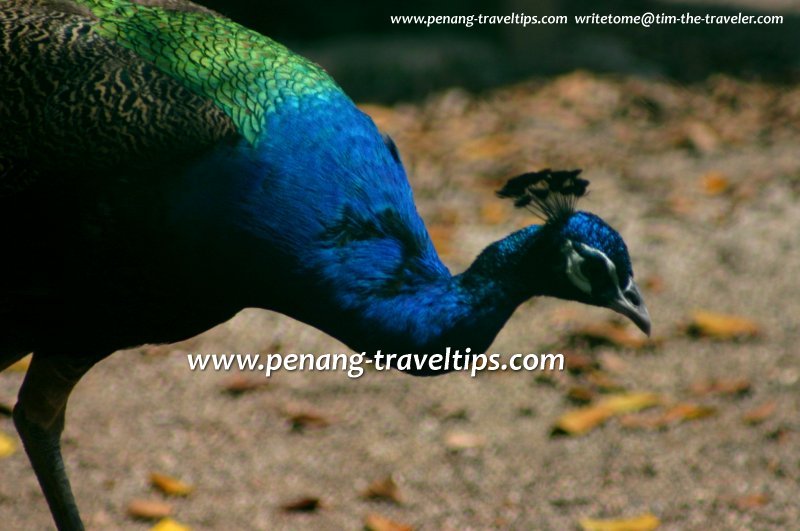 Peacock, Penang Bird Park (12 March 2005)
Peacock, Penang Bird Park (12 March 2005)
During the breeding season, the female bird will make its nest in a hole on the tree trunk, enclosing the hole to leave just a small hole. She is totally dependent on the male hornbill to pass food to her and her young. If you catch the male hornbill, you prevent it from bringing food to the female hornbill and the chicks, and in doing so, you kill the entire family.
The experienced trapper will climb up to the nest and collect only the chicks. The loss of the chicks will induce the hornbill to breed again, and this does not affect the hornbill population.
Me: How are the birds obtained for the park?
Dr Ooi: The bird park employs an experienced trapper licensed by the Jabatan Perhilitan to catch the birds, but it does so only over a controlled number. It does not trade in endangered indigenous birds. Furthermore, the Bird Park does not use poachers or bounty hunters to collect the birds.
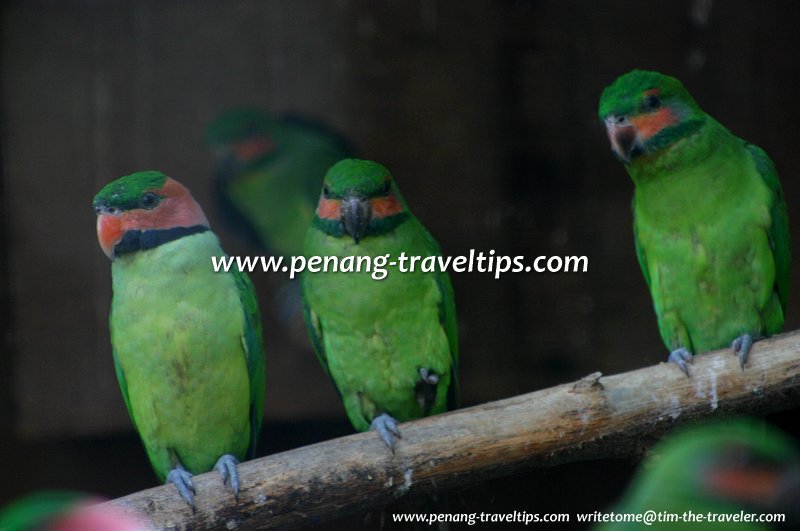 Parakeets, Penang Bird Park (12 March 2005)
Parakeets, Penang Bird Park (12 March 2005)
Let me explain the dangers of using poachers. Say you need one pair of a certain species of bird. If you send word out, perhaps ten poachers will come back with a hundred birds, gravely depleting the birds in the wild. So, I only work with my own licensed trapper, with specific instruction to get the required number. In this way, the number of birds in the wild will not be seriously harmed. On the contrary, as the Bird Park has its own incubator, it has been instrumental in increasing the number of many endangered species.
Take the Malay Crested Fireback Pheasant, for example. In the wild, it will produce only six eggs in one breeding season. These eggs are exposed to the elements, including predators such as snakes that may attack the nest and consume the eggs, and the weather. In a controlled environment such as the bird park, the eggs have a higher chance of hatching.
Secondly, when the eggs are removed from the pheasants in captivity, they will often produce another clutch of six eggs. Over a period of one year, the pheasant in captivity is capable of producing up to three clutches of eggs, totaling 18, whereas in the wild, the total output of a year is only a maximum six, and these six are subjected to the elements, such as predation from snakes and monitor lizards.
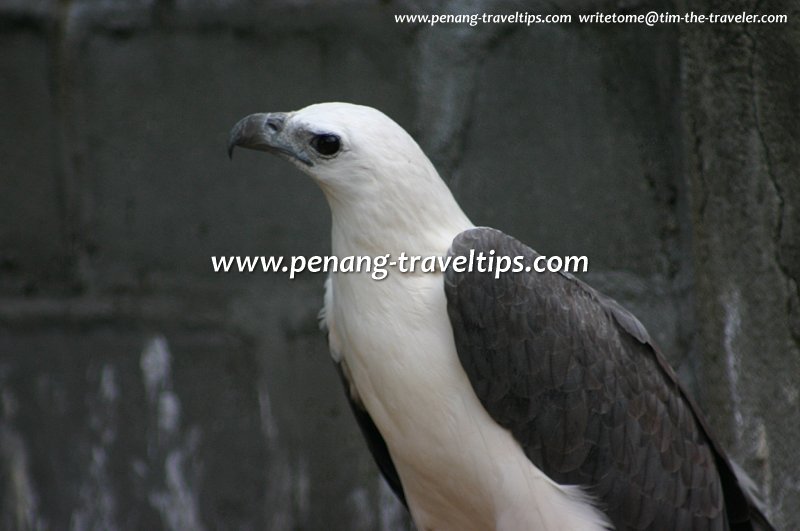 Sea Eagle, Penang Bird Park (12 March 2005)
Sea Eagle, Penang Bird Park (12 March 2005)
Due to the continuous encroachment of development on forest lands, it is simplistic to expect the birds in the wild to increase in numbers without direct human intervention. One example is the Nicobar pigeon. This bird is now close to being extinct in the wild, and is extinct in Malaysia. However, through the efforts of the Penang Bird Park, we have been successful in breeding as many as 150 birds in the last 15 years. Nowadays we have more of these pigeons in captivity than those in the wild. Without our effort, the pigeon may have been wiped off the face of the earth now.
When we do breed more than enough, we will release the birds back into the wild. We have done so in the Penang National Park at Pantai Acheh, with the co-operation from the Jabatan Perhilitan.
Me: Thank you Dr Ooi for the opportunity of talking to you.
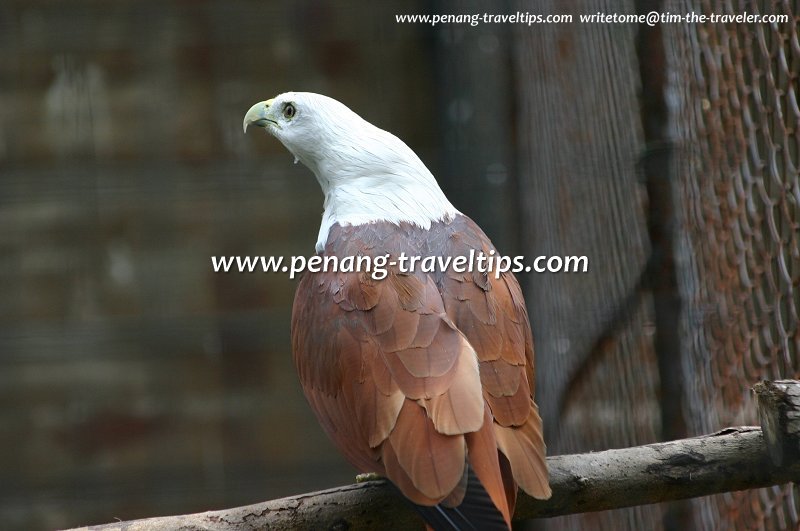 Eagle, Penang Bird Park (12 March 2005)
Eagle, Penang Bird Park (12 March 2005)
Getting there
If you're coming from the Penang Bridge, exit the North-South Expressway (E1) at the Seberang Jaya Interchange (Exit 163), and enter the Butterworth Kulim Expressway (BKE @ E15) in the direction of Butterworth.After the Petronas Petrol Station, turn left into Jalan Todak. Pass Sunway Business Park on your right. Further down, pass the Arulmigu Karumariamman Temple on your right. The Penang Bird Park is immediately after the temple.
List of Penang Tourist Attractions

Copyright © 2003-2025 Timothy Tye. All Rights Reserved.

 Go Back
Go Back